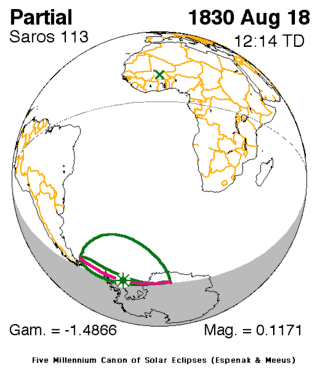Solar eclipse of August 18, 1830
A partial solar eclipse occurred on August 18, 1830 during winter. A solar eclipse occurs when the Moon passes between Earth and the Sun, thereby totally or partly obscuring the image of the Sun for a viewer on Earth. A partial solar eclipse occurs in the polar regions of the Earth when the center of the Moon's shadow misses the Earth.
| Solar eclipse of August 18, 1830 | |
|---|---|
 Map | |
| Type of eclipse | |
| Nature | Partial |
| Gamma | -1.4866 |
| Magnitude | 0.1171 |
| Maximum eclipse | |
| Coordinates | 70.7°S 50.2°W |
| Times (UTC) | |
| Greatest eclipse | 12:13:35 |
| References | |
| Saros | 113 (70 of 71) |
| Catalog # (SE5000) | 9117 |
It was one of four partial eclipses that took place that year, each two in two months, the last one was on March 30 in the same hemisphere, the next one was on September 17 and covered a part of the Northern Hemisphere.[1] It was the last two of solar saros 113, the next was on August 28, 1848.[2]
Description
The eclipse was visible over a part of the southwesternmost portion of the Atlantic, and northern Antarctica including its peninsula, its northernmost point and the surrounding islands. At the time Antarctica was discovered by the Europeans.
The eclipse started at sunrise near Tierra del Fuego, the southernmost of South America and ended at sunset in the northernmost part of Antarctica.
It showed about up to 10% obscurity in northern Antarctica and 20% at the Antarctic peninsula. The greatest eclipse was near its Antarctic Peninsula at 70.7 S, 50.2 W at 12:13 UTC (10:13 local time).[1]
The subsolar marking was in Burkina Faso.
See also
- List of solar eclipses in the 19th century
- List of solar eclipses visible from Antarctica
References
- "Solar eclipse of August 18, 1830". NASA. Retrieved March 11, 2017.
- "Solar Saros 113". NASA. Retrieved March 11, 2017.
.jpg)
